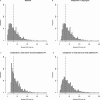Exploring the relationship between baseline physical activity levels and mortality reduction associated with increases in physical activity: a modelling study
- PMID: 24141971
- PMCID: PMC3808763
- DOI: 10.1136/bmjopen-2013-003509
Exploring the relationship between baseline physical activity levels and mortality reduction associated with increases in physical activity: a modelling study
Abstract
Background: Increasing physical activity (PA) levels among the general adult population of developed nations is important for reducing premature mortality and the burdens of preventable illness. Assessing how effective PA interventions are as health interventions often involves categorising participants as either 'active' or 'sedentary' after the interventions. A model was developed showing that doing this could significantly misestimate the health effect of PA interventions.
Methods: A life table model was constructed combining evidence on baseline PA levels with evidence indicating the non-linear relationship between PA levels and all-cause mortality risks. PA intervention scenarios were modelled which had the same mean increase in PA but different levels of take-up by people who were more active or more sedentary to begin with.
Results: The model simulations indicated that, compared with a scenario where already-active people did most of the additional PA, a scenario where the least active did the most additional PA was around a third more effective in preventing deaths between the ages of 50 and 60 years. The relationship between distribution of PA take-up and health effect was explored systematically and appeared non-linear.
Conclusions: As the health gains of a given PA increase are greatest among people who are most sedentary, smaller increases in PA in the least active may have the same health benefits as much larger PA increases in the most active. To help such health effects to be assessed, PA studies should report changes in the distribution of PA level between the start and end of the study.
Keywords: Epidemiology; Health Economics; Public Health; Social Medicine; Sports Medicine; Statistics & Research Methods.
Figures


References
-
- NICE Four commonly used methods to increase physical activity. 2006. http://www.nice.org.uk/nicemedia/live/11373/31838/31838.pdf
-
- Donaldson L. At least five a week: Evidence on the impact of physical activity and its relationship to health. A report from the Chief Medical Officer. 2004. http://www.dh.gov.uk/prod_consum_dh/groups/dh_digitalassets/@dh/@en/docu...
-
- Wilmot EG, Edwardson CL, Achana FA, et al. Sedentary time in adults and the association with diabetes, cardiovascular disease and death: systematic review and meta-analysis. Diabetologia 2012;55:2895–905 - PubMed
-
- Fogelholm M. Physical activity, fitness and fatness: relations to mortality, morbidity and disease risk factors. A systematic review. Obes Rev 2010;11:202–21 - PubMed
-
- Hex N, Bartlett C, Wright D, et al. Estimating the current and future costs of type 1 and type 2 diabetes in the UK, including direct health costs and indirect societal and productivity costs. Diabetic Med 2012;29:855–62 - PubMed
Grants and funding
LinkOut - more resources
Full Text Sources
Other Literature Sources
Research Materials
